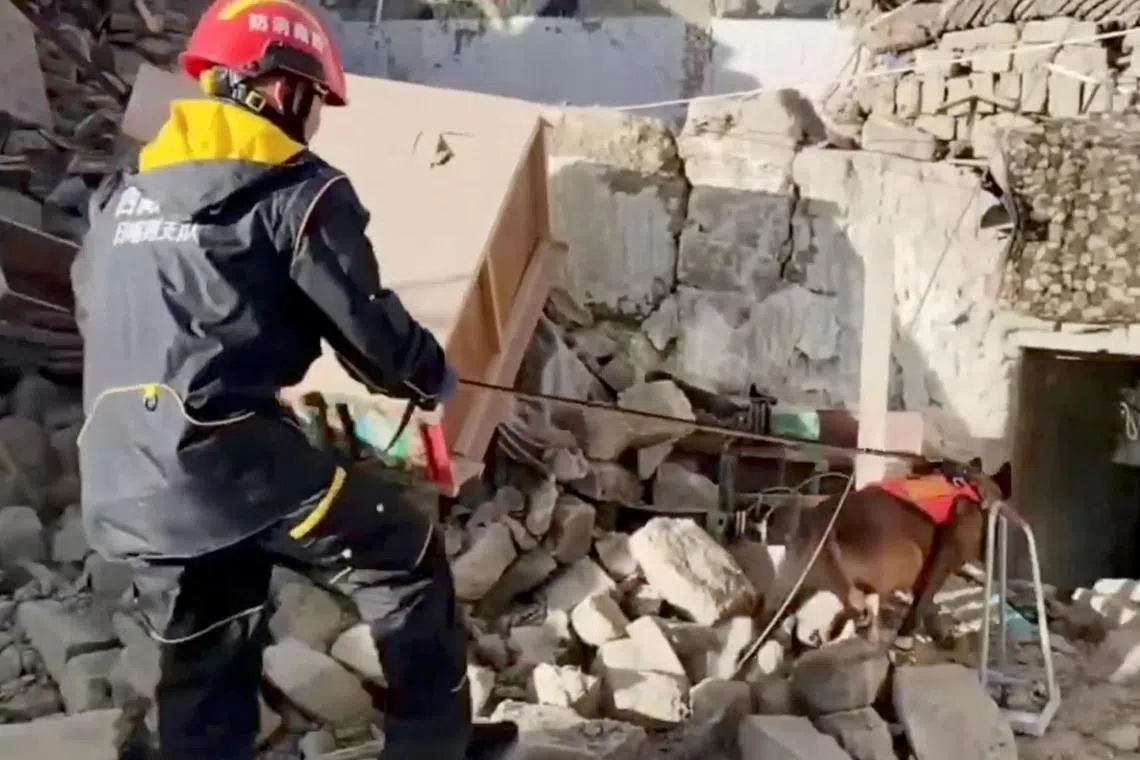Tibet earthquake: Urgency mounts in search for survivors
Sign up now: Get insights on Asia's fast-moving developments
Follow topic:
BEIJING - More than 400 people trapped by rubble in earthquake-stricken Tibet have been rescued, Chinese officials said on Jan 8, with an unknown number still unaccounted for in freezing weather a day after a strong tremor rocked the Himalayan foothills.
The epicentre of the 6.8-magnitude quake
The quake on Jan 7 also shook buildings in neighbouring Nepal, Bhutan and India.
Twenty-four hours after the temblor struck, survivors trapped under rubble would have endured a night in sub-zero temperatures, adding to the pressure on rescue workers searching in an area the size of Cambodia.
Temperatures in the high-altitude region dropped to as low as minus 18 deg C overnight. People trapped or those without shelter are at risk of rapid hypothermia and may be able to live for only five to 10 hours, even if uninjured, experts say.
Footage broadcast on state television CCTV showed families huddled in rows of blue and green tents quickly erected by soldiers and aid workers in settlements surrounding the epicentre, where hundreds of aftershocks have been recorded.
At least 126 people have died and 188 were injured on the Tibetan side, reported China’s state broadcaster CCTV. No deaths have been reported in Nepal or elsewhere.
The quake was so strong that part of the terrain at and around the epicentre slipped by as much as 1.6m over a distance of 80km, according to an analysis by the United States Geological Survey.
The Chinese authorities have yet to announce how many people are still missing.
In Nepal, an official told Reuters that the quake destroyed a school building in a village near Mount Everest, which straddles the Nepali-Tibetan border, but no one was inside at the time.
Mr Jost Kobusch, a German climber, said he was just above the Everest base camp on the Nepali side when the quake struck. His tent shook violently and he said he saw several avalanches, although he was unscathed.
“I’m climbing Everest in the winter by myself and... looks like basically, I’m the only mountaineer there; in the base camp, there’s nobody,” he told Reuters in a video call.
His expedition organising company, Satori Adventure, said Mr Kobusch had left the base camp and was descending to Namche Bazaar on Jan 8 on the way to Kathmandu.
No avalanches have been observed on Everest so far, state-run Xinhua news agency reported on Jan 8, citing Chinese scientists.
But damage round the quake’s epicentre was extensive. An initial survey showed 3,609 homes had been destroyed in Tibet’s Shigatse region,which has a population of 800,000, state media reported late on Jan 7.
More than 14,000 rescue personnel had been deployed.
More than 46,500 people affected by the quake have been relocated, and 484 tourists in Tingri have been safely transported to the city of Shigatse, local officials said at a press conference on Jan 8.
Home to some 60,000 people, Tingri is Tibet’s most populous county on China’s border with Nepal and is administered from the city of Shigatse, the traditional seat of the Panchen Lama, one of the most important figures in Tibetan Buddhism.

The 6.8-magnitude earthquake was one of the region's most powerful in recent years.
PHOTO: REUTERS
No damage has been reported to Shigatse’s Tashilhunpo monastery, state media reported, which was founded in 1447 by the first Dalai Lama.
The 14th and current Dalai Lama, Japanese Prime Minister Shigeru Ishiba, Russian President Vladimir Putin and Taiwanese President Lai Ching-te have expressed condolences to the earthquake’s victims.
500 aftershocks
South-western parts of China, Nepal and northern India are often hit by earthquakes caused by the collision of the Indian and Eurasian tectonic plates, which are pushing up an ancient sea that is now the Qinghai-Tibetan plateau.
As at noon on Jan 8, 646 aftershocks with magnitudes of up to 4.4 continued to jolt the area around the epicentre.
Over the past five years, there have been 29 earthquakes with magnitudes of 3 or above within 200km of the epicentre of Jan 7’s temblor, according to Sichuan province’s earthquake bureau.
Analysis shows a magnitude 5 to 6 quake could occur in the same area in the near future, Mr Meng Hui, deputy head of Tibet’s earthquake administration, said at the news conference.
The Jan 7 quake was the worst since a 6.2-magnitude earthquake in 2023 that killed at least 149 people in a remote north-western region of the country.
In 2008 an 8-magnitude earthquake hit Sichuan’s Chengdu, claiming the lives of at least 70,000 people, the deadliest quake to hit China since the 1976 Tangshan quake that killed at least 242,000 people. REUTERS

